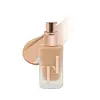What's inside
What's inside
 Key Ingredients
Key Ingredients

 Benefits
Benefits

 Concerns
Concerns

 Ingredients Side-by-side
Ingredients Side-by-side

Cyclopentasiloxane
EmollientButylene Glycol
HumectantVinyl Dimethicone/Lauryl Dimethicone Crosspolymer
Stearyl Dimethicone
EmollientOctadecene
SolventPEG-10 Dimethicone
Skin ConditioningCetyl PEG/PPG-10/1 Dimethicone
EmulsifyingDimethicone
EmollientButylene Glycol Dicaprylate/Dicaprate
EmollientAcrylates/Polytrimethylsiloxymethacrylate Copolymer
Skin ConditioningPolymethyl Methacrylate
Silica
AbrasiveAlumina
AbrasiveAcrylates/Dimethicone Copolymer
Skin ConditioningIsododecane
EmollientMethyl Trimethicone
Skin ConditioningTrimethylsiloxysilicate
EmollientQuaternium-18 Bentonite
Magnesium Sulfate
Phenoxyethanol
PreservativeHydroxyacetophenone
AntioxidantEthylhexyl Palmitate
EmollientTrihydroxystearin
Skin ConditioningSodium Hyaluronate
HumectantGlucomannan
Skin ConditioningTocopheryl Acetate
AntioxidantMagnesium Stearate
Cosmetic ColorantAluminum Hydroxide
EmollientTriethoxycaprylylsilane
Cyclopentasiloxane, Butylene Glycol, Vinyl Dimethicone/Lauryl Dimethicone Crosspolymer, Stearyl Dimethicone, Octadecene, PEG-10 Dimethicone, Cetyl PEG/PPG-10/1 Dimethicone, Dimethicone, Butylene Glycol Dicaprylate/Dicaprate, Acrylates/Polytrimethylsiloxymethacrylate Copolymer, Polymethyl Methacrylate, Silica, Alumina, Acrylates/Dimethicone Copolymer, Isododecane, Methyl Trimethicone, Trimethylsiloxysilicate, Quaternium-18 Bentonite, Magnesium Sulfate, Phenoxyethanol, Hydroxyacetophenone, Ethylhexyl Palmitate, Trihydroxystearin, Sodium Hyaluronate, Glucomannan, Tocopheryl Acetate, Magnesium Stearate, Aluminum Hydroxide, Triethoxycaprylylsilane
Water
Skin ConditioningIsohexadecane
EmollientNylon-12
Polymethylsilsesquioxane
Cetyl PEG/PPG-10/1 Dimethicone
EmulsifyingPolyglyceryl-2 Triisostearate
EmulsifyingGlycerin
HumectantUndecane
EmollientPerlite
AbsorbentPropanediol
SolventPolyglyceryl-4 Isostearate
EmulsifyingCaprylic/Capric Triglyceride
MaskingSilica
AbrasiveDisteardimonium Hectorite
StabilisingIsononyl Isononanoate
EmollientTridecane
PerfumingCyclopentasiloxane
EmollientAdipic Acid/Diglycol Crosspolymer
1,2-Hexanediol
Skin ConditioningCaprylyl Glycol
EmollientAluminum Hydroxide
EmollientTriethoxycaprylylsilane
Dimethicone Crosspolymer
Emulsion StabilisingParfum
MaskingTetrasodium EDTA
Dehydroxanthan Gum
Emulsion StabilisingTropolone
Skin ConditioningTocopherol
AntioxidantAlbatrellus Confluens Extract
HumectantAlbizia Julibrissin Bark Extract
MaskingCitric Acid
BufferingSodium Benzoate
MaskingCI 77891
Cosmetic ColorantCI 77492
Cosmetic ColorantCI 77491
Cosmetic ColorantCI 77499
Cosmetic ColorantWater, Isohexadecane, Nylon-12, Polymethylsilsesquioxane, Cetyl PEG/PPG-10/1 Dimethicone, Polyglyceryl-2 Triisostearate, Glycerin, Undecane, Perlite, Propanediol, Polyglyceryl-4 Isostearate, Caprylic/Capric Triglyceride, Silica, Disteardimonium Hectorite, Isononyl Isononanoate, Tridecane, Cyclopentasiloxane, Adipic Acid/Diglycol Crosspolymer, 1,2-Hexanediol, Caprylyl Glycol, Aluminum Hydroxide, Triethoxycaprylylsilane, Dimethicone Crosspolymer, Parfum, Tetrasodium EDTA, Dehydroxanthan Gum, Tropolone, Tocopherol, Albatrellus Confluens Extract, Albizia Julibrissin Bark Extract, Citric Acid, Sodium Benzoate, CI 77891, CI 77492, CI 77491, CI 77499
Ingredients Explained
These ingredients are found in both products.
Ingredients higher up in an ingredient list are typically present in a larger amount.
Aluminum Hydroxide is a form of aluminum. It can be naturally found in nature as the mineral gibbsite. In cosmetics, Aluminum Hydroxide is used as a colorant, pH adjuster, and absorbent.
As a colorant, Aluminum Hydroxide may add opacity, or reduce the transparency. Aluminum hydroxide is contains both basic and acidic properties.
According to manufacturers, this ingredient is an emollient and humectant. This means it helps hydrate the skin.
In medicine, this ingredient is used to help relieve heartburn and help heal ulcers.
There is currently no credible scientific evidence linking aluminum hydroxide in cosmetics to increased cancer risk.
Major health organizations allow the use of aluminum hydroxide in personal care products and have not flagged it as a carcinogenic risk at typical usage levels.
Learn more about Aluminum HydroxideThis ingredient is a high molecular weight silicone. It has emulsifying and skin conditioning properties.
Cyclopentasiloxane, or D5, is a silicone used to improve texture of products and trap moisture.
D5 is considered lightweight and volatile. Volatile means it evaporates quickly after application. Once evaporated, D5 leaves a thin barrier that helps keep skin hydrated.
It is also an emollient. Emollients help soften the skin and prevent water loss. Silicones create a silky texture in products. D5 helps other ingredients become more spreadable.
Studies show D5 is safe to use in skincare products. We recommend speaking with a skincare professional if you have concerns.
Learn more about CyclopentasiloxaneSilica, also known as silicon dioxide, is a naturally occurring mineral. It is used as a fine, spherical, and porous powder in cosmetics.
Though it has exfoliant properties, the function of silica varies depending on the product.
The unique structure of silica enhances the spreadability and adds smoothness, making it a great texture enhancer.
It is also used as an active carrier, emulsifier, and mattifier due to its ability to absorb excess oil.
In some products, tiny microneedles called spicules are made from silica or hydrolyzed sponge. When you rub them in, they lightly polish away dead skin layers and enhance the penetration of active ingredients.
Learn more about SilicaTriethoxycaprylylsilane is a silicone used to bind and stabilize ingredients.
As an emulsifier, it helps prevent ingredients from separating. This can help elongate the shelf life of products.
Triethoxycaprylylsilane is often used to coat mineral sunscreens ingredients to help give a better feel. It also helps reduce oxidative stress in sunscreens.
Learn more about Triethoxycaprylylsilane